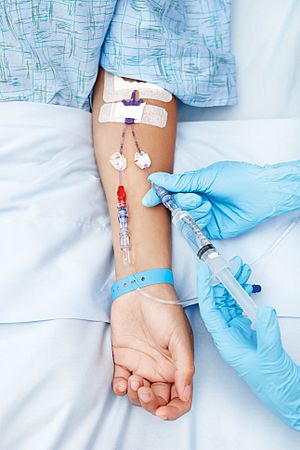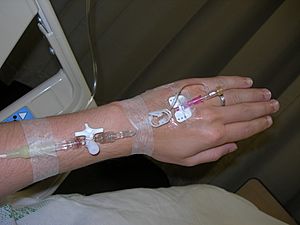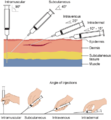Intravenous therapy facts for kids
Intravenous injection or intravenous therapy means putting liquid into a vein, using a needle. Many medications can be given intravenously.
Contents
Benefits of intravenous injection
Drugs and medications work very fast when given intravenously, because they go right into the bloodstream. They reach the brain and start working in a minute or less. Also, when a drug is given intravenously, 100% of the drug gets into the bloodstream.
When medications are given in other ways, they do not work as fast. Also, not all of the drug reaches the bloodstream.
However, medications given by IV do not last as long as medicines given by mouth As soon as the drug reaches the bloodstream, the body begins to break it down so the body can get rid of it.
Types of intravenous injections
There are two types of intravenous injections.
Intravenous line
The second type of IV injection is called an "intravenous (IV) line." This is usually what medical professionals mean when they say a patient is getting an IV.
To do an IV line, a medical professional will:
- Put a needle into the vein
- Slide a hollow plastic tube called a catheter over the needle, and into the person's vein
- Attach the catheter to longer tubes outside the patient's body
- When a patient needs fluids or medications, the medical professional will put the liquid in a bag (called an IV bag) and attach the longer tubes. The liquid then drips through the longer tubes, through the catheter, and into the person's vein
- When a medication needs to be given very quickly, a medical professional can also inject the medication right into the IV line, all at once. This is called an "IV push."
An IV line allows medical professionals to give different liquids at different times, without having to put a needle into a vein every time. They can also give many medications at the same time.
Medical uses
Intravenous lines are often used in emergency medicine. Many things can be given through an IV line.
Volume expanders
Volume expanders are special fluids that are used when a person has lost some of the fluids in their body. For example, a person might lose fluids because of dehydration or bleeding. Volume expanders are used to replace these lost fluids. They are called "volume expanders" because they expand (increase) the volume of liquid in the bloodstream.
Losing too much fluid is dangerous. People need liquid in their bloodstream to carry blood cells, glucose (sugar), electrolytes (salts), and many other important things. Usually, the blood plasma (the liquid part of blood) does this job. However, people can lose plasma for several reasons. For example:
- If a person has heavy bleeding, they will lose a lot of their plasma, along with the things it carries
- If a person gets dehydrated, they will lose some of the water in their plasma. (Normal plasma is 92% water.)
Volume expanders add to the amount of liquid in the bloodstream. They help plasma do its job.
Common volume expanders
There are a few common volume expanders. They are mixtures of liquids and other things the body loses when a person loses fluid:
- Saline: Saline is the most common volume expander. It is a mixture of water and sodium.
- Ringer's Lactate: A mixture of water and five important electrolytes: sodium, chloride, potassium, lactate, and calcium
- D5W: D5W stands for "5% dextrose in water." Dextrose is another name for glucose (sugar). The body needs glucose to make energy. D5W replaces the fluids the person has lost, and also gives them more sugar so they can make energy.
- D5W can also be mixed with saline or Ringer's Lactate to give a person extra electrolytes
Medications
Many medications can be given by IV. They can be given by themselves, or mixed into volume expanders.
Examples of medications that can be given by IV include:
- Some anti-nausea medications (used when a person is vomiting and cannot swallow medications)
- Some anti-anxiety and antipsychotic medications, like lorazepam and haloperidol (used when people are very anxious, or are psychotic)
- Medications used to put a person to sleep before surgery, like propofol
Blood
Blood transfusions are usually given through an IV line. A blood transfusion can give a person regular blood, or only parts of the blood, like:
- Plasma
- Red blood cells (these are often given alone when a person is very anemic
- White blood cells (these may be given when chemotherapy kills white blood cells)
- Platelets and/or blood-clotting proteins (given when a person's blood is not clotting well)
Nutrition
If a person cannot eat for a short time, nutrition can be given through an IV line. IV nutrition mixtures include water, electrolytes, glucose, amino acids, lipids (fats), and vitamins.
Related pages
- Other ways to give medications
- Central venous catheter (a type of IV put into a large vein in the neck, chest, or groin)
Images for kids
See also
 In Spanish: Terapia intravenosa para niños
In Spanish: Terapia intravenosa para niños








